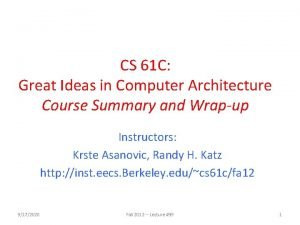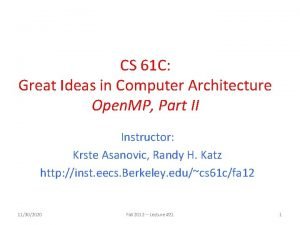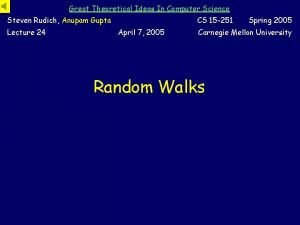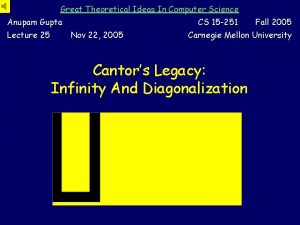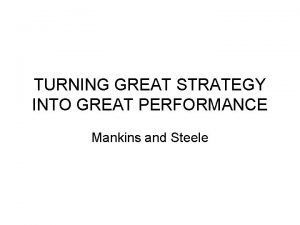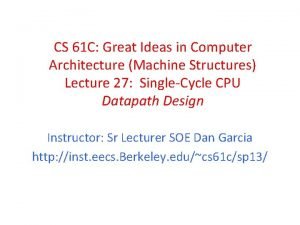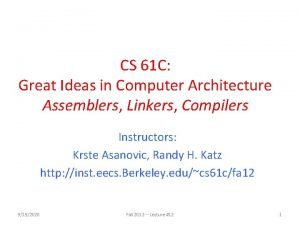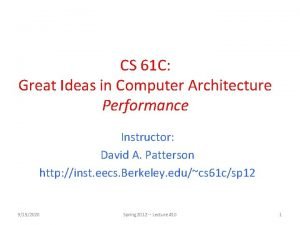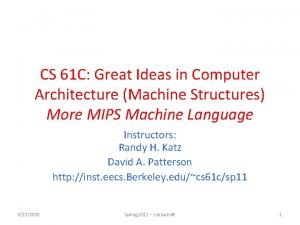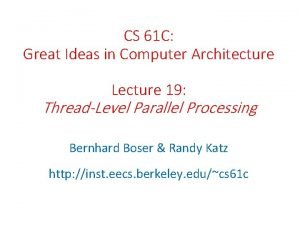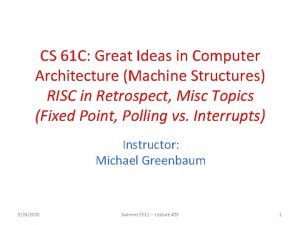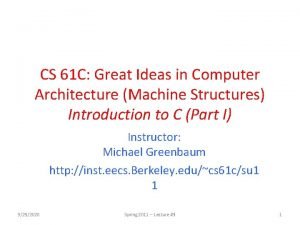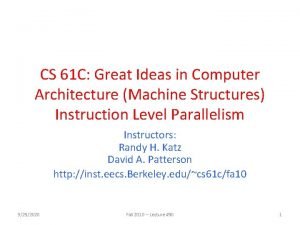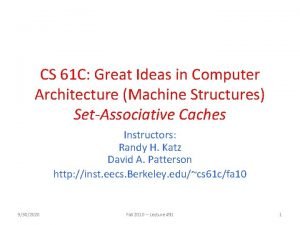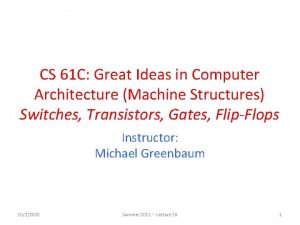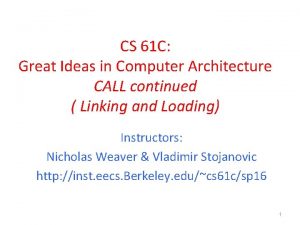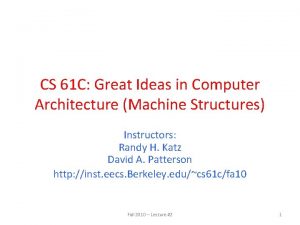CS 61 C Great Ideas in Computer Architecture











































- Slides: 43

CS 61 C: Great Ideas in Computer Architecture (Machine Structures) Instruction Level Parallelism Instructors: Randy H. Katz David A. Patterson http: //inst. eecs. Berkeley. edu/~cs 61 c/fa 10 9/25/2020 Fall 2010 -- Lecture #27 1

Agenda • • Review Pipelined Execution Pipelined Datapath Administrivia Pipeline Hazards Peer Instruction Summary 9/25/2020 Fall 2010 -- Lecture #27 2

Review: Single-cycle Processor • Five steps to design a processor: Processor 1. Analyze instruction set Input datapath requirements Control Memory 2. Select set of datapath components & establish Datapath Output clock methodology 3. Assemble datapath meeting the requirements 4. Analyze implementation of each instruction to determine setting of control points that effects the register transfer. 5. Assemble the control logic • Formulate Logic Equations • Design Circuits 9/25/2020 Fall 2010 -- Lecture #27 3

Single Cycle Performance • Assume time for actions are – 100 ps for register read or write; 200 ps for other events • Clock rate is? Instr fetch Register read ALU op Memory access Register write Total time lw 200 ps 100 ps 800 ps sw 200 ps 100 ps 200 ps R-format 200 ps 100 ps 200 ps beq 200 ps 100 ps 200 ps 700 ps 100 ps 600 ps 500 ps • What can we do to improve clock rate? • Will this improve performance as well? Want increased clock rate to mean faster programs Fall 2010 -- Lecture #27 9/25/2020 4

Gotta Do Laundry • Ann, Brian, Cathy, Dave each have one load of clothes to wash, dry, fold, and put away – Washer takes 30 minutes – Dryer takes 30 minutes – “Folder” takes 30 minutes – “Stasher” takes 30 minutes to put clothes into drawers A B C D

Sequential Laundry 6 PM 7 T a s k O r d e r A 8 9 10 11 12 1 2 AM 30 30 30 30 Time B C D • Sequential laundry takes 8 hours for 4 loads

Pipelined Laundry 6 PM 7 T a s k 8 9 3030 30 30 11 10 Time A B C O D r d e r • Pipelined laundry takes 3. 5 hours for 4 loads! 12 1 2 AM

Pipelining Lessons (1/2) 6 PM T a s k 8 9 Time 30 30 A B O r d e r 7 C D • Pipelining doesn’t help latency of single task, it helps throughput of entire workload • Multiple tasks operating simultaneously using different resources • Potential speedup = Number pipe stages • Time to “fill” pipeline and time to “drain” it reduces speedup: 2. 3 X v. 4 X in this example

Pipelining Lessons (2/2) 6 PM T a s k 8 9 Time 30 30 A B O r d e r 7 C D • Suppose new Washer takes 20 minutes, new Stasher takes 20 minutes. How much faster is pipeline? • Pipeline rate limited by slowest pipeline stage • Unbalanced lengths of pipe stages reduces speedup

Single Cycle Datapath 31 26 21 op 16 rs rt 0 immediate • Data Memory {R[rs] + Sign. Ext[imm 16]} = R[rt] bus. W Rs Rt 5 5 5 Rw Ra Rb bus. A Reg. File bus. B 32 imm 16 9/25/2020 16 Ext. Op= Extender clk 32 = ALU 32 Rs Rt Rd zero ALUctr= 0 0 32 32 1 ALUSrc= Data In Fall 2010 -- Lecture #26 clk <0: 15> Reg. Wr= <11: 15> 1 clk Instruction<31: 0> <16: 20> Rd Rt instr fetch unit <21: 25> n. PC_sel= Reg. Dst= Imm 16 Memto. Reg= Mem. Wr= 32 0 Wr. En Adr Data Memory 1 10

Steps in Executing MIPS 1) IFtch: Instruction Fetch, Increment PC 2) Dcd: Instruction Decode, Read Registers 3) Exec: Mem-ref: Calculate Address Arith-log: Perform Operation 4) Mem: Load: Read Data from Memory Store: Write Data to Memory 5) WB: Write Data Back to Register

+4 1. Instruction Fetch rd rs rt ALU Data memory registers PC instruction memory Redrawn Single Cycle Datapath imm 2. Decode/ 3. Execute 4. Memory Register Read 5. Write Back

+4 1. Instruction Fetch rd rs rt ALU Data memory registers PC instruction memory Pipeline registers imm 2. Decode/ 3. Execute 4. Memory Register Read 5. Write Back • Need registers between stages – To hold information produced in previous cycle

More Detailed Pipeline Chapter 4 — The Processor — 14

IF for Load, Store, … Chapter 4 — The Processor — 15

ID for Load, Store, … Chapter 4 — The Processor — 16

EX for Load Chapter 4 — The Processor — 17

MEM for Load Chapter 4 — The Processor — 18

WB for Load Wrong register number Chapter 4 — The Processor — 19

Corrected Datapath for Load Chapter 4 — The Processor — 20

Agenda • • Review Pipelined Execution Pipelined Datapath Administrivia Pipeline Hazards Peer Instruction Summary 9/25/2020 Fall 2010 -- Lecture #27 21

Why both rt and rd as MIPS write reg? 31 26 21 16 op 31 6 bits 26 op rs 5 bits 21 rt 5 bits 16 6 bits rs 5 bits 11 rd 5 bits rt 5 bits 6 shamt 5 bits 0 funct 6 bits 0 immediate 16 bits • Need to have 2 part immediate if 2 sources and 1 destination always in same place SPUR processor (1 st project Randy and I worked on together) 9/25/2020 Fall 2010 -- Lecture #27 22

Administrivia • Project 3: Thread Level Parallelism + Data Level Parallelism + Cache Optimization – Due Part 2 due Saturday 11/13 • Project 4: Single Cycle Processor in Logicsim – Due Part 2 due Saturday 11/27 – Face-to-Face grading: Signup for timeslot last week • Extra Credit: Fastest Version of Project 3 – Due Monday 11/29 Midnight • Final Review: TBD (Vote via Survey!) • Final: Mon Dec 13 8 AM-11 AM (TBD) 9/25/2020 Fall 2010 -- Lecture #27 23

• Hours/wk OK? avg 13, median 12 -14 (4 units = 12 hours) • Since picked earliest time for review, redoing to see if still Thu best (Mon vs Thu) 9/25/2020 Survey Fall 2010 -- Lecture #27 24

Computers in the News • Giants win World Series! (4 -1 over Dallas Texas Rangers) • “S. F. Giants using tech to their advantage” – Therese Poletti, Market. Watch , 10/29/10 • “Giants were an early user of tech, and it looks like these investments are paying off. ” – Bill Neukom (chief executive) @ Microsoft 25 years – Scouts given cameras to upload video of prospects – XO Sportsmotion, which outfits players with sensors that measure everything they do: player development, evaluate talent, rehab after injury (swing changed? ) – Internal SW development team to mine data for scouting (other teams use standard SW packages) – 266 Cisco Wi-Fi access points throughout park; 1 st in 2004 – Voice over IP to save $ internally for SF Giants 9/25/2020 Fall 2010 -- Lecture #27 25

Time IFtch Dcd Pipelined Execution Representation Exec Mem WB IFtch Dcd Exec Mem WB IFtch Dcd Exec Mem WB • Every instruction must take same number of steps, also called pipeline “stages”, so some will go idle sometimes

+4 rd rs rt ALU Data memory registers PC instruction memory Graphical Pipeline Diagrams imm 1. Instruction Fetch 2. Decode/ 3. Execute 4. Memory Register Read 5. Write Back • Use datapath figure below to represent pipeline IFtch Dcd Reg ALU I$ Exec Mem WB D$ Reg

Graphical Pipeline Representation (In Reg, right half highlight read, left half write) Time (clock cycles) Reg D$ Reg I$ Reg ALU I$ D$ ALU Reg ALU I$ ALU I n Load s t Add r. Store O Sub r d Or e r D$ Reg

Pipeline Performance • Assume time for stages is – 100 ps for register read or write – 200 ps for other stages • What is pipelined clock rate? – Compare pipelined datapath with single-cycle datapath Instr fetch Register read ALU op Memory access Register write Total time lw 200 ps 100 ps 800 ps sw 200 ps 100 ps 200 ps R-format 200 ps 100 ps 200 ps beq 200 ps 100 ps 200 ps Fall 2010 -- Lecture #27 9/25/2020 700 ps 100 ps 600 ps 500 ps 29

Pipeline Performance Single-cycle (Tc= 800 ps) Pipelined (Tc= 200 ps) Fall 2010 -- Lecture #27 9/25/2020 30

Pipeline Speedup • If all stages are balanced – i. e. , all take the same time – Time between instructionspipelined = Time between instructionsnonpipelined Number of stages • If not balanced, speedup is less • Speedup due to increased throughput – Latency (time for each instruction) does not decrease Fall 2010 -- Lecture #27 9/25/2020 31

Instruction Level Parallelism (ILP) • Another parallelism form to go with Request Level Parallelism and Data Level Parallelism • RLP – e. g. , Warehouse Scale Computing • DLP – e. g. , SIMD, Map Reduce • ILP – e. g. , Pipelined instruction Execution • 5 stage pipeline => 5 instructions executing simultaneously, one at each pipeline stage 9/25/2020 Fall 2010 -- Lecture #27 32

Hazards • Situations that prevent starting the next instruction in the next cycle • Structural hazards – A required resource is busy (roommate studying) • Data hazard – Need to wait for previous instruction to complete its data read/write (pair of socks in different loads) • Control hazard – Deciding on control action depends on previous instruction (how much detergent based on how clean prior load turns out) Fall 2010 -- Lecture #27 9/25/2020 33

Structural Hazards • Conflict for use of a resource • In MIPS pipeline with a single memory – Load/store requires data access – Instruction fetch would have to stall for that cycle • Would cause a pipeline “bubble” • Hence, pipelined datapaths require separate instruction/data memories – Really separate L 1 instruction cache and L 1 data cache Fall 2010 -- Lecture #27 9/25/2020 34

Structural Hazard #1: Single Memory Time (clock cycles) ALU I n I$ D$ Reg s Load I$ D$ Reg t Instr 1 r. I$ D$ Reg Instr 2 O I$ D$ Reg Instr 3 r D$ Reg I$ Reg d Instr 4 e r Read same memory twice in same clock cycle ALU ALU

Structural Hazard #2: Registers (1/2) Reg D$ Reg I$ Reg ALU I$ D$ ALU Reg ALU I$ ALU O Instr 2 r Instr 3 d e Instr 4 r Time (clock cycles) ALU I n s t sw r. Instr 1 D$ Reg Can we read and write to registers simultaneously?

Structural Hazard #2: Registers (2/2) • Two different solutions have been used: 1) Reg. File access is VERY fast: takes less than half the time of ALU stage • Write to Registers during first half of each clock cycle • Read from Registers during second half of each clock cycle 2) Build Reg. File with independent read and write ports • Result: can perform Read and Write during same clock cycle

Data Hazards • An instruction depends on completion of data access by a previous instruction – add sub Fall 2010 -- Lecture #27 9/25/2020 $s 0, $t 1 $t 2, $s 0, $t 3 38

Forwarding (aka Bypassing) • Use result when it is computed – Don’t wait for it to be stored in a register – Requires extra connections in the datapath Fall 2010 -- Lecture #27 9/25/2020 39

Load-Use Data Hazard • Can’t always avoid stalls by forwarding – If value not computed when needed – Can’t forward backward in time! Fall 2010 -- Lecture #27 9/25/2020 40

Code Scheduling to Avoid Stalls • Reorder code to avoid use of load result in the next instruction • C code for A = B + E; C = B + F; stall lw lw add sw $t 1, $t 2, $t 3, $t 4, $t 5, 0($t 0) 4($t 0) $t 1, $t 2 12($t 0) 8($t 0) $t 1, $t 4 16($t 0) 13 cycles Fall 2010 -- Lecture #27 9/25/2020 lw lw lw add sw $t 1, $t 2, $t 4, $t 3, $t 5, 0($t 0) 4($t 0) 8($t 0) $t 1, $t 2 12($t 0) $t 1, $t 4 16($t 0) 11 cycles 41

Peer Instruction I. Thanks to pipelining, I have reduced the time it took me to wash my one shirt. II. Longer pipelines are always a win (since less work per stage & a faster clock). A)(red) B)(orange) C)(green) D)(yellow) I is True and II is True I is False and II is True and II is False

Pipeline Summary The BIG Picture • Pipelining improves performance by increasing instruction throughput: exploits ILP – Executes multiple instructions in parallel – Each instruction has the same latency • Subject to hazards – Structure, data, control Fall 2010 -- Lecture #27 9/25/2020 44
 8 ideas of computer architecture
8 ideas of computer architecture 8 great ideas in computer architecture
8 great ideas in computer architecture 8 great ideas in computer architecture
8 great ideas in computer architecture 8 great ideas in computer architecture
8 great ideas in computer architecture Great theoretical ideas in computer science
Great theoretical ideas in computer science Great ideas in theoretical computer science
Great ideas in theoretical computer science Great theoretical ideas in computer science
Great theoretical ideas in computer science Great ideas in computer science
Great ideas in computer science Cmu 15251
Cmu 15251 Great theoretical ideas in computer science
Great theoretical ideas in computer science Great theoretical ideas in computer science
Great theoretical ideas in computer science Steven rudich
Steven rudich Great theoretical ideas in computer science
Great theoretical ideas in computer science Great theoretical ideas in computer science
Great theoretical ideas in computer science Great theoretical ideas in computer science
Great theoretical ideas in computer science 3 bus architecture
3 bus architecture Computer architecture vs organization
Computer architecture vs organization Basic computer organization
Basic computer organization Ideas have consequences bad ideas have victims
Ideas have consequences bad ideas have victims Que es una idea principal
Que es una idea principal Unit 4 great ideas
Unit 4 great ideas Turning great strategy into great performance
Turning great strategy into great performance North dakota state animal
North dakota state animal Responsible leadership meaning
Responsible leadership meaning Great white shark versus hammerhead shark
Great white shark versus hammerhead shark Does alexander the great deserve his title
Does alexander the great deserve his title Enlightened despot
Enlightened despot With great expectations comes great responsibility
With great expectations comes great responsibility A great deal vs a great many
A great deal vs a great many With great power comes great responsibility batman
With great power comes great responsibility batman Does alexander deserve to be called the great
Does alexander deserve to be called the great Oh god my father how great great is your faithfulness
Oh god my father how great great is your faithfulness What is architecture business cycle
What is architecture business cycle Return architecture
Return architecture Modular vs integral product architecture example
Modular vs integral product architecture example Types of modular architecture
Types of modular architecture Computer organization and architecture 10th solution
Computer organization and architecture 10th solution Fast desktop for architecture software
Fast desktop for architecture software Computer organization and architecture iit kharagpur
Computer organization and architecture iit kharagpur Introduction to computer organization and architecture
Introduction to computer organization and architecture Timing and control in computer architecture
Timing and control in computer architecture Computer architecture: concepts and evolution
Computer architecture: concepts and evolution I/o modules in computer architecture
I/o modules in computer architecture Floating point division algorithm in computer architecture
Floating point division algorithm in computer architecture

